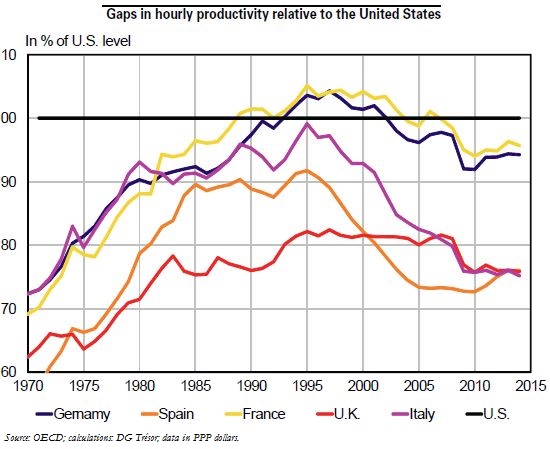Trésor-Economics No. 170 - Why is Italian productivity so weak?
After a period of robust growth due to a catch-up effect until the mid-1990s, Italy experienced a sharper and earlier slowdown in labour productivity than its main partners. Italy was one of the European leaders in hourly labour productivity until the mid-1990s. This advantage has gradually narrowed. Today, Italian productivity is 20% below that of France and Germany.
Italy's weak productivity performance is not due to a change in production structure or to regional disparities. The lack of productivity gains is common to all economic sectors, and the shift in the production structure–particularly the contraction in manufacturing-does not explain the economy-wide slowdown.
From a cyclical perspective, the policies aimed at increasing the labour content of growth have slowed hourly productivity gains. The labour-market reforms of the late 1990s and early 2000s sustained job creation amid weak economic growth, curbing productivity gains. The 2008 crisis caused a decline in employment that, while substantial, was moderate relative to the shock on Italy's economy and by comparison with other European countries–notably Spain. This reflects the fact that the labour-market adjustment was achieved mainly through a reduction in hours worked per employee.
In a longer-term perspective, Italy's atypical situation in Europe seems due to structural factors. The first is the lag in labour-force education and training, particularly for the young, which restricts the supply of skilled jobs. At the same time, the integration of young people–including the highest educated–into the labour market is difficult, and this can lead to an inefficient use of human capital. The second factor is that investment in R&D and information and communication technologies (ICTs) has been far lower than in the other European countries. Third, Italy's lag in adopting reforms of the goods and services markets may also have limited labour productivity gains.
Another cause of weak Italian productivity is the small size of firms, a great majority of which are family-owned and not significantly internationalised. While the percentage of microenterprises is the same as in France, the gap in productivity by firm size is far wider in Italy.
